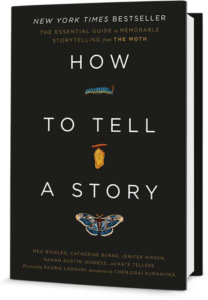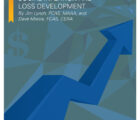Storytelling can be an actuary’s secret weapon.
 It was a freezing winter night, and Tim was stranded in the middle of nowhere. He’d been traveling around England, making a documentary. He’d missed the last bus to the village where he was staying, and there were no taxis. But after a minute’s thought, Tim ordered a pizza.
It was a freezing winter night, and Tim was stranded in the middle of nowhere. He’d been traveling around England, making a documentary. He’d missed the last bus to the village where he was staying, and there were no taxis. But after a minute’s thought, Tim ordered a pizza.
Curious about what happened next? That may be the power of storytelling at work.
Tim asked for the pizza to be delivered to his hotel in the next town, then asked if he could ride along. The pizza — and Tim — arrived safely. In How to Tell a Story, co-author Catherine Burns describes her friend Tim’s anecdote as perfect for a job interview. “The story demonstrates that Tim is a creative problem solver, with an adventurous spirit and a great sense of humor,” she writes. “Think through the stories in your arsenal before the interview and have one or two prepped.”
A friendly guide to developing your own storytelling skills, How to Tell a Story may be one of the most unusual books to find an audience in the business world in recent years. Yet it’s been longlisted for both the Porchlight Business Book Award and Inc.’s Non-Obvious Book Award. The book’s five co-authors are all hosts and producers with The Moth, a nonprofit founded in 1997 that focuses on a simple act: people telling short, true stories about their lives, in front of an audience. Some of those live stories are later featured on The Moth Podcast, which receives 100 million annual downloads, or The Moth Radio Hour, which airs nationally.
Co-author Sarah Austin Jenness, who oversees The Moth Podcast, agrees that job interviews are a setting where storytelling can shine. “Having a few anecdotes and scenes can help you stand out from the rest,” she says. “Most people just answer questions with facts and declarative sentences, which aren’t quite as memorable.”
On the surface, the ability to tell a story might not seem like a skill that actuaries need. But being able to craft a narrative is increasingly seen as an important tool. Similar to the tools outlined in the recent CAS webinar, “Communication Skills for Actuaries,” storytelling can help actuaries succeed when meeting with clients or the C-suite.
Job interviews are just one setting where creating a narrative can make a difference. The book guides readers to use storytelling to write grant proposals, give presentations, build teams or just deliver a toast at a retirement party.
In any of those situations, making information memorable can be the key to success. The authors credit cognitive psychologist Jerome Bruner with the statement, “We are twenty-two times more likely to remember a fact when it has been wrapped in a story.”
Jenness is also part of The Moth Works Department, which has brought storytelling workshops to businesses including Google, American Express and MetLife. At one tech company, scientists were trying to show just how sensitive, and therefore cutting-edge, their experiments were. They tried to explain it with data — lots and lots of data.
But over lunch, one scientist told a little anecdote. He explained that the team had to schedule their work around a train station more than two miles away because the movement of the trains disrupted the experiments. “Years later,” states the book, “we still remember that story; the data was supplemental.” In a scenario that may seem familiar to actuaries, the stakeholders whom the scientists needed to convince didn’t respond well to data. It turned out that a story brought them the buy-in they needed.
 As an organization, The Moth practices what it preaches. According to Jenness, the nonprofit has begun holding quarterly storytelling workshops for staffs. “Even in our own Moth work environment,” Jenness says, “you feel like sometimes you don’t know your coworkers very well. Now in this day and age of hybrid workplaces, you have fewer of the water cooler moments. People are very busy, with an incredible pile of work on their desks. And so personal stories can be very short, but they can really help to break down barriers and connect people.” After a three-hour storytelling workshop, Jenness says, “Some of the scenes that folks are sharing, they’re rough stories, but they’re gorgeous. And I’ve seen my co-workers in a totally different light.”
As an organization, The Moth practices what it preaches. According to Jenness, the nonprofit has begun holding quarterly storytelling workshops for staffs. “Even in our own Moth work environment,” Jenness says, “you feel like sometimes you don’t know your coworkers very well. Now in this day and age of hybrid workplaces, you have fewer of the water cooler moments. People are very busy, with an incredible pile of work on their desks. And so personal stories can be very short, but they can really help to break down barriers and connect people.” After a three-hour storytelling workshop, Jenness says, “Some of the scenes that folks are sharing, they’re rough stories, but they’re gorgeous. And I’ve seen my co-workers in a totally different light.”
The feeling of connection that storytelling inspires has recently been backed up by science. The book cites a study led by neuroscientist Uri Hasson, which found that “when a person is listening and comprehending a story, their brain activity begins to couple, or align, with the brain of the teller … MRI scans of two brains, one talking, one listening, showed that the brains began to sync.”
“You are driving this tour bus through your story, and you choose which scenes your passengers see — what we cruise past or where we pull over for a closer look.”
— How to Tell a Story
Once people feel connected, changing minds can be an easier task. “I’ve worked a lot with people who are advocates and activists, and some of them are scientists, doctors and lawyers, and people who are trying to make a difference in the world,” says Jenness. “It’s an incredibly different experience if you roll into the room with statistics about an issue … compared to when you say, ‘When I was 24, I was fired for being a woman.’ I think hearing from someone who has lived it is quite different from hearing about it.”
A narrative can also provide a roadmap for a co-worker facing a problem. Sometimes sharing a story from your own life can help a team member handle the same situation. For example, most people have had to face a fear at work, whether it’s nerves over chairing a meeting or dealing with a VIP. And what if that VIP was one of the world’s spiritual leaders? Jenness has a story about that.
“One day, the United States Institute of Peace asked me to help young peacebuilders tell stories for the Dalai Lama,” said Jenness. “Of course, I said yes, but then I was terrified! I shut Zoom off, and I felt like I was levitating. But then the ticket came, I packed my bag, and I went — terrified the whole time, and acting like I really had it down.”
“There were three days of convening, and on the very first day, I was in a very short and small meeting with the Dalai Lama. So, the meeting was very, very serious, of course. There were only six of us in the room with him, and we were talking about how the convening would go with all the 50 peacebuilders the next day. And I was very quiet.”
“At the very end, I remembered I had brought him gifts because I had been told that he likes gifts. Everyone was filing out, and I felt my body just say something. It’s like body versus mind. ‘Oh, your Holiness,’ I said. My mind was hearing this like I was astral projecting. And he said, ‘Yes?’ And I said, ‘I brought you gifts.’ And he said, ‘Gifts?’”
Then a photographer entered the room, and Jenness handed the Dalai Lama the book How to Tell a Story and said, “I also help people tell stories for peace and better understanding,” to which he nodded. “But then I gave him a Yankees cap. And he was really excited about the Yankees cap,” she continued. “So, he put the Yankees hat on, and now I have all these strange photographs of me standing next to the Dalai Lama, and he’s wearing a Yankees hat and holding The Moth book.”
What did Jenness take away from the experience? “I think that even people who have skills and are supposed to be masters in their fields, just get really scared, and work through it. It’s a battle sometimes, mind over matter. I thought that trip was truly memorable, but it included a lot of moments where I was just terrified … I think that’s what is so beautiful about stories. We can share the stories and then learn from each other and feel closer.”
Getting Started
Everyone has a story, but how do you find yours? How to Tell a Story breaks down the process into a series of logical steps. One way of beginning is to mine your memories. Think of a place, an object, or a relationship that was important to you. Big changes can also kick off a story. Sometimes it’s a decision that marks a turning point, such as deciding to switch career paths, leave a job, go back to school or speak up. Jenness says that many stories are based on the first time, the last time, the best time or the worst time.
As you pick a topic, remember that vulnerability can be the key to making a story work. “It’s okay to celebrate success,” the book states, “but that success will be more interesting if you tell us about your stumbles along the way.”
For example, The Moth worked with astronaut Michael Massimino as he developed his story, “A View of the Earth.” Massimino pitched the idea by saying, “I could tell you about the time I broke the Hubble Telescope.” While Massimino eventually found a way to solve the problem, the writers point out that “most of us will never be sent into outer space by NASA. But who can’t relate to spending many hours of your life preparing for something important, only to be undermined by something as tiny and common as a stripped screw?”
Once you’ve picked a story, the next step is to develop it more fully by creating scenes. According to the writers, “You are driving this tour bus through your story, and you choose which scenes your passengers see — what we cruise past or where we pull over for a closer look.” Describe those scenes using details to make the story seem vivid and real. Some of those details can come from your senses, like the smell of cookies baking or the sound of rain on a roof. A detail can also be what you were thinking at the time.
When it’s time to tell your story, the Moth team says it’s better not to memorize it or write it down. Instead, they suggest just familiarizing yourself with your story, by practicing telling it out loud. According to the authors, if you read the story, “You’re less present in the room. You risk losing connection with the listener.” Instead, use the Moth method: Memorize only the first and last lines of your story.
It’s normal to feel nervous when telling a story for the first time. “If you feel your voice trembling,” the writers advise, “pause and take a deep breath before you speak again. You may not be able to outwardly acknowledge your nerves, but a moment of silence can steady you.”
While the stories told on Moth stages are usually five minutes or longer, Jenness says the book can also be used to craft the much shorter narratives that can be useful at work. “I’ve seen people use very short stories to open up keynotes, team meetings and board meetings,” says Jenness. “Any time you can add a little bit of your own humanity and how you see the world, I think that you build rapport immediately.”
If you’re ready to bring storytelling to work, the most important thing, according to Jenness, is to simply get started. “I would challenge people to just try it,” she says. “Try telling a story, even if it’s just one minute long. And just see what the response is, and see how it makes you feel, and see how others light up. Because it really can be life-changing.”
Listen to some work stories
A college student answers the phone at her hometown newspaper during the Watergate hearings.
A doctor declares her first death in the hospital.
A writer becomes a New York City sanitation worker and learns why the work matters.
To hear these and other Moth stories that take place on the job, visit https://themoth.org/tags/jobs-employment.
Kick off a meeting with a story
The Moth team has some ideas to get people talking. Following are a few prompts they suggest from How to Tell a Story:
- About the work: Tell us about a time you realized this work was important to you.
- About the theme of the meeting (for example, expanding into new markets): Tell us about a time you knew you had to leave home.
- About company values (for example, working with integrity): Tell us about a time you had to stand up for what’s right.
Laurie McClellan is a freelance writer and photographer living in Arlington, Virginia.













